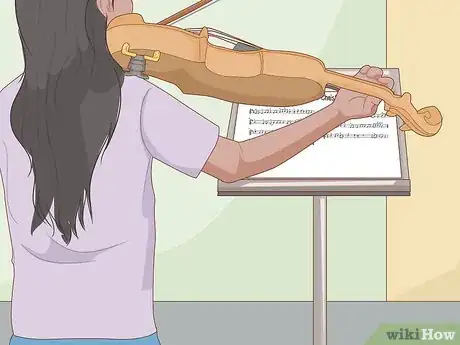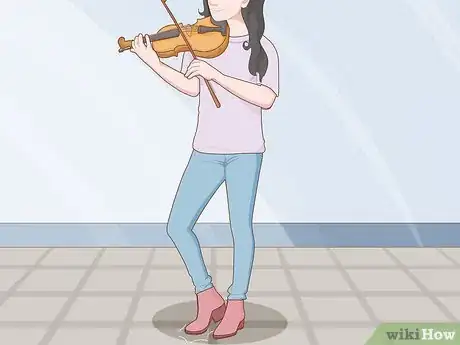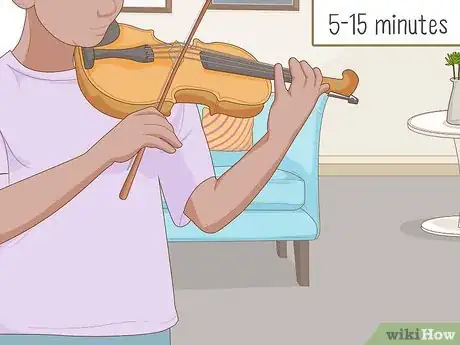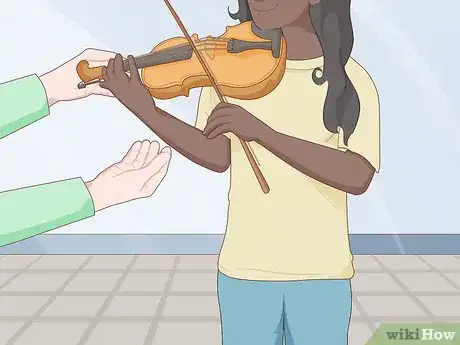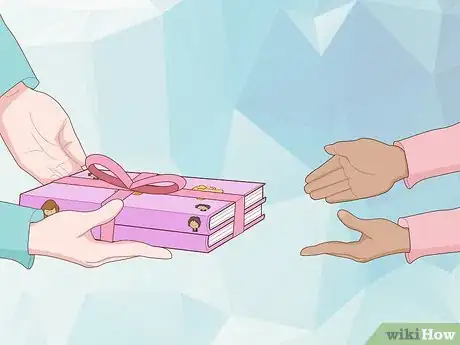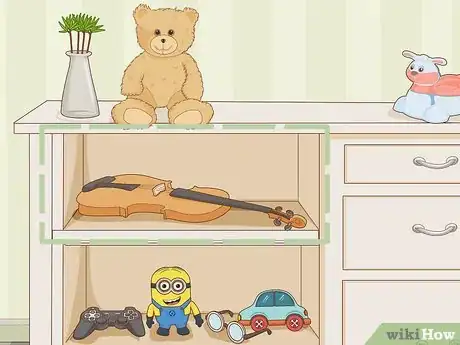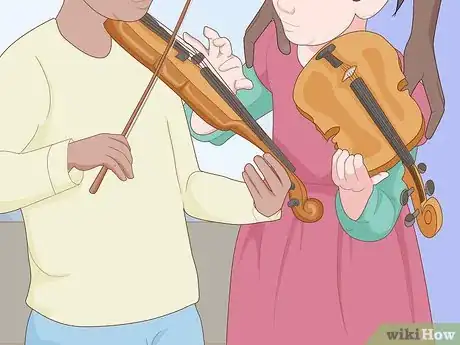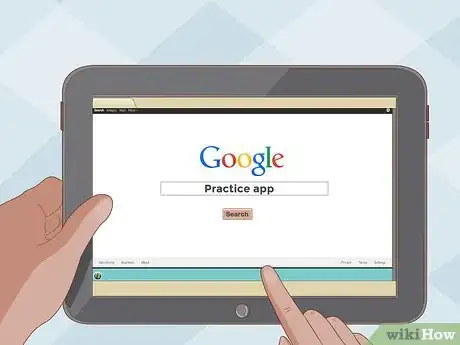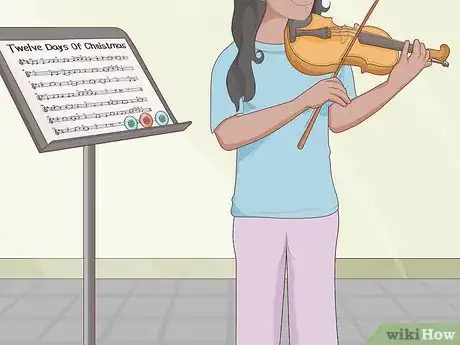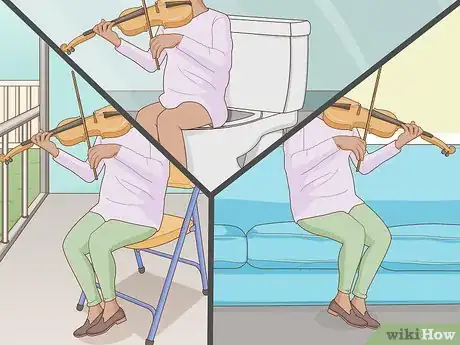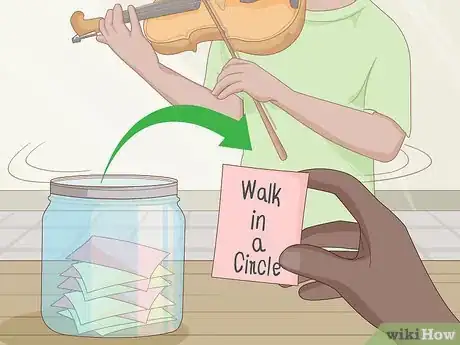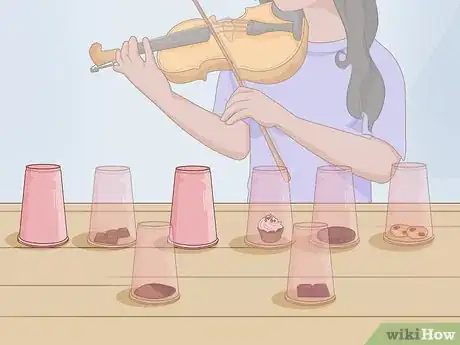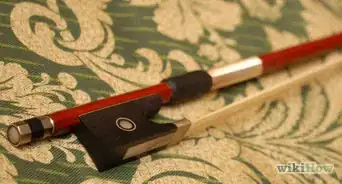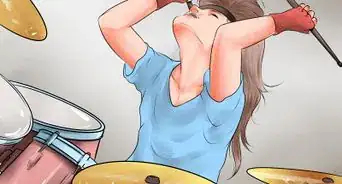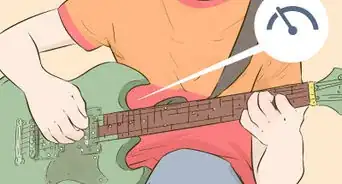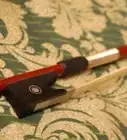This article was co-authored by Dalia Miguel and by wikiHow staff writer, Danielle Blinka, MA, MPA. Dalia Miguel is a violinist and violin instructor based in the San Francisco Bay Area. She is studying Music Education and Violin Performance at San Jose State University and has been playing violin for over 15 years. Dalia teaches students of all ages and performs with a variety of symphonies and orchestras in the Bay Area.
This article has been viewed 41,036 times.
The violin is a beautiful instrument, but learning to play it can be frustrating at times. If practicing the violin is becoming a chore, you're likely looking for ways to making things more interesting. Make your practice sessions more engaging by mixing up your sections, adding new material, or moving around more. If your child is learning violin, encourage them to practice more by setting goals and offering rewards. Additionally, you can play practice games.
Steps
Making Practice More Engaging
-
1Alternate between hard and easy sections. This can add some variety to your practice sessions and will help you stay interested. For instance, you might start out with an easy section, then switch to something hard. Continue switching it up until you're finished practicing for the day.[1]
- If the songs you're practicing are too easy for you, then you'll get bored after the first few minutes. Similarly, music that's too difficult will make you feel frustrated. Switching between the two will keep you striving toward something while also letting you feel a sense of achievement.
-
2Incorporate new songs or scales if you're bored. It's normal to get tired of playing the same thing all of the time. You need to have something to work toward. Ask your teacher for advice on how to move to the next skill level. Then, add something new to your practice sessions.[2]
- What you add will depend on how long you've been playing. Beginners might start learning a different scale or may start learning a song. On the other hand, violinists with some experience might start learning more complicated songs. Advanced violinists may start practicing solos.
- You can get more advanced instruction at home by watching tutorials online or by using an app. For instance, you can find the apps Learn Violin or Classical Violinist on iPhone, while Android users can try Violin Notes or Violin Lesson Tutor.
Advertisement -
3Play your favorite songs, if you're ready. Once you've started playing music, talk to your teacher about learning to play one of your favorite songs. Even if it's going to take a bit of work for you to play it well, getting to play something you love will be an incentive to keep working.[3]
- Before you talk to your teacher, make a list of songs you'd be interested in learning. Then, ask them which ones would be best for your current skill level. You can always save the others for later!
- Don't expect to play the song perfectly the first time.
- Put your own spin on the song by changing the arrangement or playing around with the melody. For instance, you might slow down the tempo or do a mashup of 2 songs.
Tip: As you get better at playing the violin, don't limit yourself to classical music. If you enjoy a particular genre, such as rock or country, start learning to play those songs.
-
4Imagine you're giving a performance. Put yourself into various scenarios that would allow you to show off your skills on the violin. Even if you're just getting started, picture what it will be like when you've mastered your instrument. Let these daydreams motivate you to keep practicing so you can really take center stage some day. For instance, you might:
- Pretend you're a soloist in a big concert hall.
- Picture yourself playing for your favorite celebrities.
- Pretend you're playing with your favorite musician.
-
5Try incorporating movement as you play. You don't have to stand in one spot while you play your violin. Instead, try swaying or dancing with your instrument. If this is too hard, just try taking a few steps to challenge yourself. Use your movement to express the mood of the music.
- For example, celebrity violinist Joshua Bell closes his eyes and sways as he plays, while fiddler Mairead Nesbitt of Celtic Women jumps and twirls as she plays. Similarly, YouTube violinist Jun Sung Ahn choreographs dance routines to her violin.
-
6Break long sessions into 2-3 short sessions. As you become a more advanced violist, you'll likely be practicing your instrument more. For instance, it's common for advanced players to practice for an hour or more each day. Doing a long session can feel tedious and tiring, but breaking it up into several short sessions may help. That way, you'll get all of your practice in without losing interest.[4]
- For instance, if you typically practice for an hour a day, you might practice for 30 minutes in the morning and 30 minutes after school.
Encouraging Your Child to Practice
-
1Start with 5-15 minute practice sessions, then slowly increase the time. When kids are first learning to play the violin, they'll get frustrated very quickly. Playing scales over and over again gets boring after just a few minutes, so it's normal for them to want to stop. Don't set high goals for the first few weeks. Instead, have your child practice for 5-15 minutes a day, then increase their sessions when their teacher recommends it.[5]
- Ask your child's teacher for advice on how long they should be practicing. Make it a habit to ask, “How many minutes a day should they practice this week?” after every class.
- If your child says they want to keep playing, let them continue practicing, and praise them for trying so hard. Say, “I'm really impressed with your work ethic!”
-
2Make goals for each practice session so your child has purpose. Ask your child's teacher what skills they should be focused on. Then, set a small, measurable goal to help your child work toward the skills they're learning. Tell your child what the goal is, as well as why their working towards it.[6]
- For instance, the goal might be to "play the scale perfectly," "hold the bow correctly," or "play the first section perfectly."
- Do your best to set a goal that your child can attain during this session. If you're not sure what to do, ask their teacher what kinds of goals they should be pursuing at this stage of their development.
Tip: Goals can motivate your child in 3 ways. First, they give them something to work towards, so your child is able to feel accomplished. Second, they ensure each practice session is focused, so the time isn't wasted. Finally, goals provide a sense of purpose.
-
3Reward your child when they reach practice goals. Earning rewards will give your child an incentive to practice, and you can decide how and when they get rewarded. Your rewards can be anything that motivates your child. For instance, you might reward them with something like: [7]
- Screen time
- Candy
- Their favorite food
- Fun pencils
- Gel pens
- Coupons to get out of chores
- New violin accessories
- Books
- Gift cards for their favorite streaming services
-
4Keep the violin in a spot where it's easily accessible. If your child has to work hard to get their violin out for practice, they'll be less motivated to do it. The act of taking something out and putting it away may become an easy excuse to skip practice for the day. Instead, keep the violin within easy reach. You may even put it on a display stand in your child's room rather than in a case.[8]
- If you keep the violin on display, it's very important that it get used often. Otherwise, dust may build up on it.
-
5Encourage your child to make friends who also play violin. If your child is the only one in their friend group who is learning an instrument, they may feel like they're missing out when their friends do other activities. Having a friend who plays violin may encourage your child to stick with it. Additionally, they may enjoy practicing together.[9]
- Talk to the parents of other children who attend lessons with your child's teacher to find out if they have a child around the same age as yours.
- If your child goes to a music school, go to their events so that you and your child can meet the other students.
-
6Try a practice app to motivate your child. There are apps that help you learn different instruments, including violin. Your child may feel more motivated to practice if they're using an app. You can find apps that switch up lessons, give motivation, and let your child connect with other kids who play the violin.[10]
- For instance, you can try the Better Practice App.
Playing Practice Games
-
1Do a token race to help you master harder sections. Line up 3 coins along the left side of your music stand. Play the hardest section in the song you're learning. If you play it well, advance a token. Then, play the section again, and advance the second token if you play it well. If you make a mistake, return all of the tokens to the starting position. Continue until all of your tokens have advanced across the music stand or for up to 15 minutes.[11]
- You can use any small item as a token. For instance, buttons or cookies can also make great tokens.
-
2Go on a “tour” of your home or neighborhood. Instead of practicing in the same room for your entire session, play each section in a different room. Start in your typical practice space, such as your bedroom. Then, move to the bathroom, kitchen, living room, and porch. Alternatively, take your practice session outside and pick a few houses to serve as your tour destinations.[12]
- If anyone is around, thank them for coming to your concert, then play for them. Even if you make a mistake, they'll likely be delighted and give you applause.
- If you're nervous, ask someone, like a parent, guardian, or sibling, to go with you.
Variation: Instead of doing a “tour,” your child could play a sold out violin concert for their dolls, action figures, or stuffed animals. Line up the toys on a couch or bed so they can “listen” to your child play.
-
3Use silly cards or sticks to make practice playful. Take a deck of cards or some popsicle sticks and write different gestures on them, such as “stick out your tongue,” “close your eyes,” or “stand on one foot.” Then, put them in a jar. During practice, pull out one card or stick before you play each section. Perform the section while doing the gesture on the card or stick.[13]
- For instance, let's say your stick says, “walk in a circle.” While you play the next section, you'd walk around in a circle until it's finished.
- Other gestures you might write on your cards or sticks include, “shake your bottom,” “close one eye,” “do fish lips,” “sing along,” “wiggle your nose,” or “sway.”
-
4Play “pick a cup” with hidden treats. Ask a friend or family member to set up 8-10 cups, with 5-6 treats placed under them. After each section, pick a cup to see if you get a treat. Keep practicing until all of your treats are found.[14]
- Ideally, it's best to have more cups than sections you plan to practice. That way you don't accidentally find all of the treats before you finish playing.
- Treats can be candies or small items, depending on what you prefer. For instance, you might keep a big bowl of things you like, such as bite-sized candies, trinkets, costume jewelry, nail polish, hot wheels, makeup samples, bouncy balls, etc.
Expert Q&A
Did you know you can get expert answers for this article?
Unlock expert answers by supporting wikiHow
-
QuestionHow long should a beginner practice violin every day?
 Dalia MiguelDalia Miguel is a violinist and violin instructor based in the San Francisco Bay Area. She is studying Music Education and Violin Performance at San Jose State University and has been playing violin for over 15 years. Dalia teaches students of all ages and performs with a variety of symphonies and orchestras in the Bay Area.
Dalia MiguelDalia Miguel is a violinist and violin instructor based in the San Francisco Bay Area. She is studying Music Education and Violin Performance at San Jose State University and has been playing violin for over 15 years. Dalia teaches students of all ages and performs with a variety of symphonies and orchestras in the Bay Area.
Experienced Violin Instructor
-
QuestionHow many hours a day should I practice violin?
 Dalia MiguelDalia Miguel is a violinist and violin instructor based in the San Francisco Bay Area. She is studying Music Education and Violin Performance at San Jose State University and has been playing violin for over 15 years. Dalia teaches students of all ages and performs with a variety of symphonies and orchestras in the Bay Area.
Dalia MiguelDalia Miguel is a violinist and violin instructor based in the San Francisco Bay Area. She is studying Music Education and Violin Performance at San Jose State University and has been playing violin for over 15 years. Dalia teaches students of all ages and performs with a variety of symphonies and orchestras in the Bay Area.
Experienced Violin Instructor
-
QuestionHow much should I practice?
 Community AnswerThis depends on how much improvement you want to see. At a beginner level (elementary school), 15 minutes per day should suffice. At an amateur level (grades 6-10), 30-45 minutes a day is a good idea. If you choose to continue with violin at a higher level, you should determine how much practice is right for you, but it should definitely be more than an hour. In general, the more you practice, the better your playing will be and the more fun you can have playing advanced music.
Community AnswerThis depends on how much improvement you want to see. At a beginner level (elementary school), 15 minutes per day should suffice. At an amateur level (grades 6-10), 30-45 minutes a day is a good idea. If you choose to continue with violin at a higher level, you should determine how much practice is right for you, but it should definitely be more than an hour. In general, the more you practice, the better your playing will be and the more fun you can have playing advanced music.
Warnings
- Don't judge yourself or compare yourself to others. Everyone has different talents, and it takes time to become good at something. If you want to measure your growth, compare yourself to past you.⧼thumbs_response⧽
- Don't push yourself too hard or set unrealistic goals. Otherwise, you'll likely get frustrated and burnout.⧼thumbs_response⧽
References
- ↑ https://www.connollymusic.com/stringovation/how-can-i-make-violin-practice-fun-for-my-child
- ↑ https://www.connollymusic.com/stringovation/how-can-i-make-violin-practice-fun-for-my-child
- ↑ https://www.willanacademy.com/can-make-violin-practice-fun-child/
- ↑ https://www.connollymusic.com/stringovation/how-can-i-make-violin-practice-fun-for-my-child
- ↑ https://musicteacherla.com/violin-practice-games-for-kids/
- ↑ https://www.connollymusic.com/stringovation/how-can-i-make-violin-practice-fun-for-my-child
- ↑ https://www.connollymusic.com/stringovation/how-can-i-make-violin-practice-fun-for-my-child
- ↑ https://www.connollymusic.com/stringovation/how-can-i-make-violin-practice-fun-for-my-child
- ↑ https://www.willanacademy.com/can-make-violin-practice-fun-child/
- ↑ https://betterpracticeapp.com/
- ↑ https://www.connollymusic.com/stringovation/how-can-i-make-violin-practice-fun-for-my-child
- ↑ https://musicteacherla.com/violin-practice-games-for-kids/
- ↑ https://musicteacherla.com/violin-practice-games-for-kids/
- ↑ https://musicteacherla.com/violin-practice-games-for-kids/


